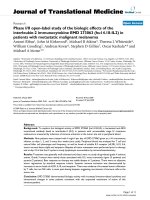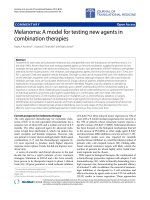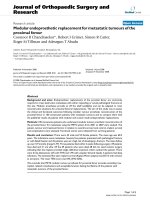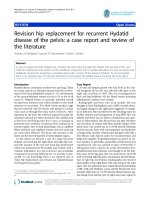báo cáo hóa học:" Modular endoprosthetic replacement for metastatic tumours of the proximal femur" doc
Bạn đang xem bản rút gọn của tài liệu. Xem và tải ngay bản đầy đủ của tài liệu tại đây (270.36 KB, 8 trang )
BioMed Central
Page 1 of 8
(page number not for citation purposes)
Journal of Orthopaedic Surgery and
Research
Open Access
Research article
Modular endoprosthetic replacement for metastatic tumours of the
proximal femur
Coonoor R Chandrasekar*, Robert J Grimer, Simon R Carter,
Roger M Tillman and Adesegun T Abudu
Address: Royal Orthopaedic Hospital, Birmingham, UK
Email: Coonoor R Chandrasekar* - ; Robert J Grimer - ; Simon R Carter - ;
Roger M Tillman - ; Adesegun T Abudu -
* Corresponding author
Abstract
Background and aims: Endoprosthetic replacements of the proximal femur are commonly
required to treat destructive metastases with either impending or actual pathological fractures at
this site. Modular prostheses provide an off the shelf availability and can be adapted to most
reconstructive situations for proximal femoral replacements. The aim of this study was to assess
the clinical and functional outcomes following modular tumour prosthesis reconstruction of the
proximal femur in 100 consecutive patients with metastatic tumours and to compare them with
the published results of patients with modular and custom made endoprosthetic replacements.
Methods: 100 consecutive patients who underwent modular tumour prosthetic reconstruction of
the proximal femur for metastases using the METS system from 2001 to 2007 were studied. The
patient, tumour and treatment factors in relation to overall survival, local control, implant survival
and complications were analysed. Functional scores were obtained from surviving patients.
Results and conclusion: There were 45 male and 55 female patients. The mean age was 60.2
years. The indications were metastases. Seventy five patients presented with pathological fracture
or with failed fixation and 25 patients were at a high risk of developing a fracture. The mean follow
up was 15.9 months [range 0–77]. Three patients died within 2 weeks following surgery. 69 patients
have died and 31 are alive. Of the 69 patients who were dead 68 did not need revision surgery
indicating that the implant provided single definitive treatment which outlived the patient. There
were three dislocations (2/5 with THR and 1/95 with unipolar femoral heads). 6 patients had deep
infections. The estimated five year implant survival (Kaplan-Meier analysis) was 83.1% with revision
as end point. The mean TESS score was 64% (54%–82%).
We conclude that METS modular tumour prosthesis for proximal femur provides versatility; low
implant related complications and acceptable function lasting the lifetime of the patients with
metastatic tumours of the proximal femur.
Published: 4 November 2008
Journal of Orthopaedic Surgery and Research 2008, 3:50 doi:10.1186/1749-799X-3-50
Received: 14 June 2008
Accepted: 4 November 2008
This article is available from: />© 2008 Chandrasekar et al; licensee BioMed Central Ltd.
This is an Open Access article distributed under the terms of the Creative Commons Attribution License ( />),
which permits unrestricted use, distribution, and reproduction in any medium, provided the original work is properly cited.
Journal of Orthopaedic Surgery and Research 2008, 3:50 />Page 2 of 8
(page number not for citation purposes)
Introduction
Metastatic bone tumours commonly arise from carci-
noma of the breast, bronchus, kidney, prostate and thy-
roid. There are many publications on bony metastases,
surgical management, complications and outcomes [1-
26]. The proximal femur is the commonest long bone to
be affected by secondary malignant bone tumours [1,2]
The use of endoprostheses for the treatment of malignant
tumours of the proximal femur is well recognized and its
use in metastatic disease is also becoming more common.
The original endoprostheses were custom made hence
there was a time delay to manufacture the implant, as a
result modular implants have become popular in many
centres. They have the advantage of allowing surgical
treatment without delay for many tumours and they are
especially useful for patients with pathological fractures
due to metastases. Many pathological fractures of the
proximal femur will not heal, either because of the disease
process itself or because of the use of radiotherapy and in
patients with good life expectancy and destruction of the
upper femur, an endoprosthetic replacement is both func-
tionally and oncologically a sensible option.
The main principle in treating any pathological fracture
due to metastatic bone disease is that the fracture should
be fixed in such a way that the patient can, if possible,
resume as near normal function as soon as possible and
that whatever fixation device is used, it should outlive the
patient. The advantage of an endoprosthetic replacement
over internal fixation of the proximal femur is that it will
allow removal of the tumour involved area and replace-
ment, thus minimising the risk of further tumour related
problems like non-union and tumour progression [2,3].
The main potential complications of the use of endopros-
theses are local recurrence, infection, aseptic loosening,
mechanical failure and fracture (prosthetic or bone) [4-6].
There are many publications on the use of custom and
modular proximal femoral endoprosthetic replacements
[7-11]. We have used custom made endoprosthetic
replacements for tumours of the proximal femur since
1970 [12] and we have been using the modular proximal
femoral endoprosthetic replacements [METS prosthesis
system designed by Stanmore Implants Worldwide] since
they became available in 2001.
The aim of this study was to assess the clinical and func-
tional outcomes following modular tumour prosthesis
reconstruction of the proximal femur in 100 consecutive
patients with metastatic tumours and to compare them
with the published results of patients with modular and
custom made endoprosthetic replacements.
Patients and methods
Between 2001 to 2007, 100 consecutive patients under-
went resection of the proximal femur and modular endo-
prosthetic replacement for metastatic disease of the
proximal femur. Seventy five patients presented with
pathological fracture or with failed fixation and 25
patients were at a high risk of developing fracture. The
patients who were referred with metastatic tumours of the
proximal femur were discussed at the multi-disciplinary
meeting and the treatment option was chosen. Endopros-
thetic replacement was preferred when there was a) failed
fixation, b) gross destruction of the proximal femur not
suitable for internal fixation c) metastatic disease with
good prognosis – e.g. solitary renal metastasis. The opera-
tions were all carried out at a single institution by the
oncological surgical team. Patient, tumour, treatment and
outcome data on all cases was prospectively entered into
a database.
All of the modular prostheses were designed and manu-
factured at the Department of Biomedical Engineering of
the Institute of Orthopaedics of University College, Lon-
don (now known as Stanmore Implants Worldwide,
SIW). This modular system provides a choice of different
femoral head sizes, trochanteric reattachment, femoral
stem and shaft size and length. There is also an option to
use a polished or hydroxyapatite coated collar at the bone-
prosthesis junction in the expectation that there will be
osseointegration with the prosthesis which will hopefully
decrease the problem of late aseptic loosening.
All operations were performed in a clean air theatre. Anti-
biotic prophylaxis was given at the time of surgery and for
up to 24 hours post-operatively. The tumour resection was
carried out following oncological principles. In patients
with secondary bone tumours with pathological fractures
and failed implants with possible involvement of the hip
joint a palliative reconstruction (marginal or planned
involved margins) was carried out. An en bloc resection
was carried out in patients without pathological fractures
aiming to achieve a wide margin. Surgery was performed
in the lateral position with a longitudinal incision includ-
ing excision of the biopsy tract. The appropriate segment
of the proximal femur was resected. In patients requiring
proximal femoral replacement and whose disease spared
the greater trochanter, this was osteotomised and reat-
tached to the endoprostheses using the trochanteric reat-
tachment plate and screws or cable-grip wires. If it was not
possible to preserve the greater trochanter the abductor
mechanism was sutured to vastus lateralis and fascia lata.
There was also an option to reattach the abductors to the
trochanteric holes in the implant with non-absorbable
sutures. Trial components were used to select the appro-
priate size of components needed to restore limb length
and stability. The femoral head was replaced with either a
monopolar head or with an acetabular replacement
depending on the status of the acetabulum. The hip cap-
sule was preserved whenever possible. Prior to the reduc-
Journal of Orthopaedic Surgery and Research 2008, 3:50 />Page 3 of 8
(page number not for citation purposes)
tion of the prosthesis a strong absorbable suture was used
circumferentially around the capsule. The prosthesis was
reduced and the capsule was tightened and repaired in a
'purse string' fashion increasing the stability. Monopolar
heads were preferentially used for the reconstruction,
whilst a cemented acetabular component was used in
patients with either degenerative changes at the hip or
with possible tumour involvement of the acetabulum. A
smooth round or oval collar was used at the prosthesis-
femur interface for the patients as the anticipated life
expectancy was less than five years and Hydroxyapatite
collars were selectively used. The stems were cemented,
using low viscosity antibiotic containing bone cement,
introduced with a cement gun.
We have used large monopolar heads in 95% of the
patients with metastatic disease. Five patients had a
cemented acetabular polyethylene cup with a 28 mm
metal head. The mean length of femoral resection was 9
cm (range 4.5 cm to 21 cm) and all patients had a
cemented intramedullary stem.
Following surgery patients were mobilized supervised
weight bearing helped by experienced physiotherapists,
progressing to full weight bearing by time of discharge at
two weeks. The resection histology was reviewed at the
multi disciplinary meeting and further treatment includ-
ing radiotherapy was planned. At six weeks post surgery
patients returned to the hospital for a period of intensive
inpatient physiotherapy. Patients were followed up with
three monthly appointments for two years, followed by
six monthly appointments until five years post surgery.
The radiographs of patients who were alive for more than
24 months were analysed using the ISOLS guidelines [13].
Functional assessment of the surviving patients was
assessed using the TESS questionnaire, a well validated
patient completed assessment of function [14].
We analysed the patient and prosthetic survival, the risk of
revision of the prosthesis, the incidence of failure of limb
salvage because of amputation and complications like dis-
location and infection following the use of the modular
prosthetic replacement of the proximal femur. We have
used Kaplan Meier survival curves to assess the failure
rates of the prostheses. We have compared these outcomes
with the published results of custom and modular proxi-
mal femoral endoprosthetic replacements. Throughout
the time period of this study our unit carried out limb sal-
vage in 99% of patients with metastatic tumours of the
proximal femur using the modular system.
Results
Between 2001 and 2007, 100 patients underwent modu-
lar endoprosthetic replacement of the proximal femur.
There were 45 male and 55 female patients. The mean age
was 60.2 years. The indications were metastases. The indi-
cations are shown in Table 1. Seventy five patients pre-
sented either with a pathological fracture (56 patients) or
with a failed fixation (19 patients) (Figure 1a, b) and 25
patients were at a high risk of developing fracture.
The complications were dislocation 3%, infection 6%,
local recurrence 4% and peri-operative mortality 3%.
There were three post operative dislocations of the hip.
Two dislocations occurred in two of the five patients who
had acetabular reconstruction using a 28 mm femoral
head and a polyethylene liner (40%). One dislocation
occurred in one of the 95 patients with unipolar heads
(1%). The three patients had closed reduction of the dis-
location. There were no early cup revisions for disloca-
tion.
Six patients developed a wound infection of whom five
were early (within three months of surgery) and one late
(after three months). Three patients were treated success-
fully with wound debridement and antibiotics, two
patients had persistent chronic infection treated with long
term antibiotics and one patient eventually required a hip
disarticulation. Sixteen patients were noted to have
received post operative radiotherapy in the present series
and none of them developed a deep infection.
Local recurrence arose in four patients (4%) after 9, 9, 12
and 25 months after the index surgery. Local recurrence
occurred in patients with a previous pathological fracture.
Two of these patients had palliative treatment because of
widespread disease; two patients had more extensive
reconstruction (one conversion to a total femur replace-
ment and Harrington reconstruction of the acetabulum).
One patient had a hip disarticulation for infection. The
limb salvage rate was 99% for the present series.
Three patients required revision surgery. (Two for local
recurrence and acetabular erosion, one had revision to
total femur for tumour progression). We have used large
monopolar heads in 95% of the patients with metastatic
disease and only 2% (2 patients) needed further revision
surgery for acetabular erosion. The estimated one and five
year implant survival was 100% and 83.1% with revision
as end point (Figure 2).
The mean follow up was 15.9 months (range 0–77
months). There were three perioperative deaths, due to
pulmonary embolism in elderly patients who had been
on prolonged bed rest prior to the operation, and a further
three patients had a pulmonary embolism postopera-
tively. Sixty nine patients have died and 31 are alive. Of
Journal of Orthopaedic Surgery and Research 2008, 3:50 />Page 4 of 8
(page number not for citation purposes)
Typical indications for a proximal femoral replacementFigure 1
Typical indications for a proximal femoral replacement. a) Failed fixation of a proximal femoral fracture due to meta-
static breast carcinoma b) Progressive destruction of proximal femur by metastatic renal carcinoma c) Radiograph of the mod-
ular endoprosthetic replacement at 12 months.
Journal of Orthopaedic Surgery and Research 2008, 3:50 />Page 5 of 8
(page number not for citation purposes)
the 69 patients who were dead 68 did not need revision
surgery indicating that the implant provided single defin-
itive treatment which outlived the patient. One patient
had revision surgery. The estimated one, two and three
year patient survival (Kaplan-Meier analysis) was 35%,
21% and 10% respectively (Figure 3). Twenty five patients
lived more than two years after the surgery. Eleven of these
patients had metastatic renal carcinoma and six had met-
astatic breast carcinoma. The estimated one year patient
survival (Kaplan-Meier analysis) after the proximal femo-
ral endoprosthetic replacement for metastatic renal, breast
and bronchogenic carcinoma was 86%, 40% and 10%
respectively (Figure 4).
The radiographs of 25 patients who survived more than
24 months were analysed according to the ISOLS guide-
lines [13]. Greater trochanter related problems were seen
in six patients who had sparing and reattachment (3 prox-
imal migration, 2 broken wires and one calcification). No
other patient had any adverse features on the radiographs.
A functional assessment questionnaire (the TESS score)
was sent to all surviving patients. The mean TESS score for
patients with metastatic bone tumours was 64% (54% –
82%).
Discussion
Limb salvage using proximal femoral endoprosthetic
replacements, allografts and allograft prosthesis compos-
ite have been reported [4,7,8,10-12]. Long term results of
custom proximal femoral replacement showed implant
survival without revision was 77% at 10 years and 57% at
Table 1: Patient diagnoses
Total 100
Diagnosis Ca breast 28
Ca renal 23
Ca bronchus 11
Ca prostate 5
Ca Thyroid 3
Adenocarcinoma 9
Other diagnoses 21
Prosthetic survival without revisionFigure 2
Prosthetic survival without revision.
Patient Survival after surgery (35% at 1 year, 21% at 2 years and 10% at 3 years)Figure 3
Patient survival after surgery (35% at 1 year, 21% at 2
years and 10% at 3 years).
Patient survival after endoprosthetic replacement of the proximal femur for metastatic renal, breast and broncho-genic carcinomaFigure 4
Patient survival after endoprosthetic replacement of
the proximal femur for metastatic renal, breast and
bronchogenic carcinoma (renal – right, middle –
breast and left – bronchus).
0
.2
.4
.6
.8
1
Cum. Survival
72 8401224364860
Time in months
Journal of Orthopaedic Surgery and Research 2008, 3:50 />Page 6 of 8
(page number not for citation purposes)
20 years [12]. Custom implants are not readily available
and for patients with pathological fractures and failed
trauma implant fixations of the proximal femur, custom
implants are not ideal due to the delay in their availabil-
ity, resulting in enforced bed rest with the associated mor-
bidity. Occasionally, tumour progression during this
delay may compromise the margins of resection if a cus-
tom made prosthesis is chosen. Based on the extensive
experience in the use of custom endoprostheses, Stan-
more Implants Worldwide introduced modular endo-
prosthetic replacement of the proximal femur in 2001.
One hundred patients with metastatic bone tumours
formed the present series and most of these patients had
an actual or impending pathological fracture or a failed
implant. Primary bone tumours formed the major indica-
tion for proximal femoral replacement in most of the pub-
lished series [4,7,11,12]. The success of a prosthesis is
judged by its ability to provide a solid, functioning pros-
thesis without complications for the remainder of that
patient's life. This has been achieved for 68 of the 69
patients (98.5%) who died with the implant in situ, with-
out any revision being required.
The problem of infection following proximal femoral
endoprosthetic replacement has been highlighted by sev-
eral authors [4,6,11,12]. The rate of reported infection
varied from 1.2% to 19.5%.(Table 2). The rate of infection
in the present series was 6% and this is comparable to the
incidence of 6.3% reported by Menendez et al [7] using a
modular prosthesis in a series of 96 patients but is consid-
erably lower than the rate of infection of 19.5% reported
by Gosheger et al [11] in 41 patients who underwent
modular proximal femoral endoprosthetic replacement.
This high infection rate was attributed to 4 patients receiv-
ing post operative radiotherapy following resection of
Ewing's sarcoma. Radiotherapy is known to be a signifi-
cant risk factor in relation to infection of the endopros-
thetic replacements [6]. In our series 16 patients received
radiotherapy and none of them developed deep infection.
Dislocation is a well recognized complication with proxi-
mal femoral endoprosthetic replacement with the
reported rates of dislocation varying from 1.7% to 20%
[7,11,12]. This is due to the extensive resection of soft tis-
sues around the hip, including muscles and hip capsule in
most cases. Repairing both the hip capsule and the abduc-
tor lever arm is difficult. Most authors have reported a
high dislocation rate with the use of small femoral head
sizes in this location after tumour resection and larger
head sizes do seem preferable to try and reduce this. The
dislocation rate of 3% in the present series is comparable
to other reported series (Table 2). The dislocation rate was
17% in a series of 54 patients with primary bone tumours
treated with custom implants from our centre [12]. The
use of a monopolar large femoral head resulted in the dis-
location rate being reduced to 3% in the present series.
Two of the five patients who had a total hip type of recon-
struction had a dislocation. We have used large monopo-
lar heads in 95 patients with metastatic disease and only
2% (2 of the 95) needed further revision surgery for
acetabular erosion indicating that large monopolar heads
can be safely used for patients with metastatic disease
without acetabular involvement. We used monopolar
heads in this series specifically to reduce the risk of dislo-
cation.
Aseptic loosening is a well recognised complication with
the use of custom and modular implants with long term
follow up [4,11,12]. We have used hydroxyapatite coated
collars for patients with anticipated long term survival to
reduce the risk of aseptic loosening especially in patients
with metastatic renal carcinoma. This has been shown to
be very effective for both distal femoral and proximal tib-
ial replacements [16,17]. Long term follow up will be
needed to assess whether this is equally effective for prox-
imal femoral replacements.
Pathological fractures of the proximal femur may not heal
despite internal fixation with intramedullary nail and post
operative radiotherapy. This is more common with meta-
Table 2: Comparing complications and implant survival of the published series of custom and modular proximal femoral
endoprosthetic replacement with the present series
Author Infection Local Recurrence Dislocation Revision 5 Year Survival
Kabukckuoglu
12
[custom]
54 patients [1972–1992]
1.8% 28% 11% 17%
Unwin
4
[custom]
263 patients [1968–92]
2.7%* 4.6%* 6.1%
Gosheger
11
[modular]
41 patients [1992–03]
19.5% 7.3% 78.7%
Menendez
7
[modular]
96 patients [1992–03]
6.3% 3.1% 10.4% 7.3% 82%
Present Series [modular]
100 patients [2001–07]
6% 4% 3% 3% 83.1%
* had revision surgery
Journal of Orthopaedic Surgery and Research 2008, 3:50 />Page 7 of 8
(page number not for citation purposes)
static renal carcinoma [15,18,23,26]. The tumour can
progress causing the eventual failure of the implant neces-
sitating further surgery. The risk of reoperation following
failed internal fixation for metastases is between 20% –
35% [18,19,25]. This is related to the type of the meta-
static tumour and duration of survival. The present study
has shown that 86% of the patients with metastatic renal
carcinoma and 40% of the patients with metastatic breast
carcinoma were alive at one year following the endopros-
thetic replacement surgery. The long term survival of
patients with metastatic renal carcinoma is well known
[15,23,26]. The local failure rate following internal fixa-
tion was 24% for metastatic renal carcinoma [23]. Hence
primary endoprosthetic replacement should be consid-
ered as a treatment option for patients with renal metas-
tases as the failure rate of the endoprostheses is low
compared with internal fixation. Wedin et al [15]
recorded a 14% failure rate for osteosynthetic devices
compared with 2% for the endoprosthesis. Because of the
low failure rate the endoprosthesis is more cost effective
and it provides a strong, permanent, stable construct that
allows immediate return to functional mobility lasting the
lifetime of the patient with the metastatic disease of the
proximal femur.
The justification for using proximal femoral replacement
surgery with a one year mortality of 65% is debatable.
Wedin et al [18] reported 30% one year, 10% two years
and 7% three years patient survival following surgery for
proximal femoral metastases. The estimated one, two and
three year patient survival for the present series is 35%,
20% and 10% respectively. The estimated one year sur-
vival for patients with metastatic renal carcinoma was
86%. For a patient with metastatic disease of the proximal
femur often with pathological fracture and failed fixation,
surgery with its inherent risks and the potential benefits is
often the better option than bed rest, palliation and radi-
otherapy. Patients with a pathological fracture not suita-
ble for internal fixation or failed fixation with a life
expectancy of at least six weeks were offered the option of
proximal femoral endoprosthetic replacement An
informed choice was made by the patient based on the
recommendations of the multi disciplinary team. The
patients who died within the first year had a stable pain
free proximal femur. This enabled them to have some
mobility and dignity during the precious last few months
of their lives improving the quality of life.
The overall risk of amputation following modular proxi-
mal femoral replacement in this series was 1% and was
directly related to the risk of infection. We conclude that
in our hands a modular proximal femoral endoprosthesis
has fulfilled its aim of providing reasonable function with
a low rate of complications improving the quality of life
for the patients with metastatic disease of the proximal
femur. We recommend the use of proximal femoral endo-
prosthetic replacement for patients with proximal femoral
metastases with a) failed fixation, b) gross destruction of
the proximal femur not suitable for internal fixation c)
metastatic disease with good prognosis. A monopolar
head can be safely used for most patients and if there is
acetabular involvement or degeneration a cemented
acetabular replacement is indicated.
Authors contributions
All authors contributed to the article.
Competing interests
The authors declare that they have no competing interests.
References
1. Damron TA, Sim FH: Surgical treatment for metastatic disease
of the pelvis and the proximal end of the femur. Instr Course
Lect 2000, 49:461-470.
2. British Orthopaedic Association and the British Orthopae-
dic Oncology Society. Metastatic Bone Disease. A Guide to
Good Practice 2001.
3. Tillman RM: The role of the orthopaedic surgeon in metastatic
disease of the appendicular skeleton. Working Party on Met-
astatic Bone Disease in Breast Cancer in the UK. J Bone Joint
Surg Br 1999, 81(1):1-2.
4. Unwin PS, Cannon SR, Grimer RJ, Kemp HB, Sneath RS, Walker PS:
Aseptic loosening in cemented custom made prosthetic
replacements for the bone tumours of the lower limb. J Bone
Joint Surg Br 1996, 78(1):5-13.
5. Jeys LM, Grimer RJ, Carter SR, Tillman RM: Risk of amputation fol-
lowing limb salvage surgery with endoprosthetic replace-
ment, in a consecutive series of 1261 patients. Int Orthop 2003,
27(3):160-3.
6. Jeys LM, Grimer RJ, Carter SR, Tillman RM: Periprosthetic Infec-
tion in patients treated for an orthopaedic oncological con-
dition. J Bone Joint Surg Am 2005, 87(4):842-849.
7. Menendez LR, Ahlmann ER, Kermani C, Gotha H: Endoprosthetic
reconstruction for neoplasms of the proximal femur. Clin
Orthop Relat Res 2006, 450:46-51.
8. Clarke HD, Damron TA, Sim FH: Head and neck replacement
endoprosthesis for pathologic proximal femoral lesions. Clin
Orthop Relat Res 1998:210-7.
9. Freedman EL, Eckardt JJ: A modular endoprosthetic system for
tumor and non-tumor reconstruction: preliminary experi-
ence. Orthopedics 1997, 20(1):27-36.
10. Zeegen EN, Aponte-Tinao LA, Hornicek FJ, Gebhardt MC, Mankin HJ:
Survivorship analysis of 141 modular metallic endoprosthe-
ses at early followup. Clin Orthop Relat Res 2004:239-50.
11. Gosheger G, Gerbert C, Aherns H, Streitbuerger A, Winkelmann W,
Hardes J: Endoprosthetic replacement in 250 patients with
sarcoma. Clin Orthop Relat Res 2006:164-171.
12. Kabukcuoglu Y, Grimer RJ, Tillman RM, Carter SR: Endoprosthetic
replacement for primary malignant tumours of the proximal
femur. Clin Orthop Relat Res 1999:8-14.
13. ISOLS Implant radiological evaluation protocol Accessed on 5/
10/2007 [ />].
14. Davis AM, Wright JG, Williams JI, Bombardier C, Griffin A, Bell RS:
Development of a measure of physical function for patients
with bone and soft tissue sarcoma. Qual Life Res 1996,
5(5):508-516.
15. Wedin R, Bauer HC, Wersall P: Failures after operation for skel-
etal metastatic lesions of long bones. Clin Orthop Relat Res
1999:128-139.
16. Myers GJ, Abudu AT, Carter SR, Tillman RM, Grimer RJ: Endopros-
thetic replacement of the distal femur for bone tumours:
long term results. J Bone Joint Surg [Br] 2007, 89:521-6.
17. Myers GJ, Grimer RJ, Abudu A, Carter SR, Tillman RM: The long-
term results of endoprosthetic replacement of the proximal
Publish with BioMed Central and every
scientist can read your work free of charge
"BioMed Central will be the most significant development for
disseminating the results of biomedical research in our lifetime."
Sir Paul Nurse, Cancer Research UK
Your research papers will be:
available free of charge to the entire biomedical community
peer reviewed and published immediately upon acceptance
cited in PubMed and archived on PubMed Central
yours — you keep the copyright
Submit your manuscript here:
/>BioMedcentral
Journal of Orthopaedic Surgery and Research 2008, 3:50 />Page 8 of 8
(page number not for citation purposes)
tibia for bone tumours. J Bone Joint Surg Br 2007,
89(12):1632-1637.
18. Wedin R, Bauer HC: Surgical treatment of skeletal metastatic
lesions of the proximal femur: endoprosthesis or reconstruc-
tion nail? J Bone Joint Surg Br 2005, 87(12):1653-7.
19. Bauer HC, Wedin R: Survival after surgery for spinal and
extremity metastases. Prognostication in 241 patients. Acta
Orthop Scand 1995, 66(2):143-6.
20. Eckardt JJ, Kabo JM, Kelly CM, Ward WG Sr, Cannon CP: Endopros-
thetic reconstructions for bone metastases. Clin Orthop Relat
Res 2003:S254-62.
21. Selek H, Başarir K, Yildiz Y, Sağlik Y: Cemented
endoprosthetic replacement for metastatic bone disease in
the proximal femur. J Arthroplasty 2008, 23(1):112-7.
22. Marco RA, Sheth DS, Boland PJ, Wunder JS, Siegel JA, Healey JH:
Functional and oncological outcome of acetabular recon-
struction for the treatment of metastatic disease. J Bone Joint
Surg Am 2000, 82(5):642-51.
23. Lin PP, Mirza AN, Lewis VO, Cannon CP, Tu SM, Tannir NM, Yasko
AW: Patient survival after surgery for osseous metastases
from renal cell carcinoma. J Bone Joint Surg Am 2007,
89(8):1794-801.
24. Sarahrudi K, Hora K, Heinz T, Millington S, Vécsei V: pathological
fractures of the long bones: a retrospective analysis of 88
patients. Int Orthop 2006, 30(6):519-24.
25. Wedin R, Bauer HC, Rutqvist LE: Surgical treatment for skeletal
breast cancer metastases: a population-based study of 641
patients. Cancer 92(2):257-62.
26. Fuchs B, Trousdale RT, Rock MG: Solitary bony metastasis from
renal cell carcinoma: significance of surgical treatment. Clin
Orthop Relat Res 2005:187-92.









